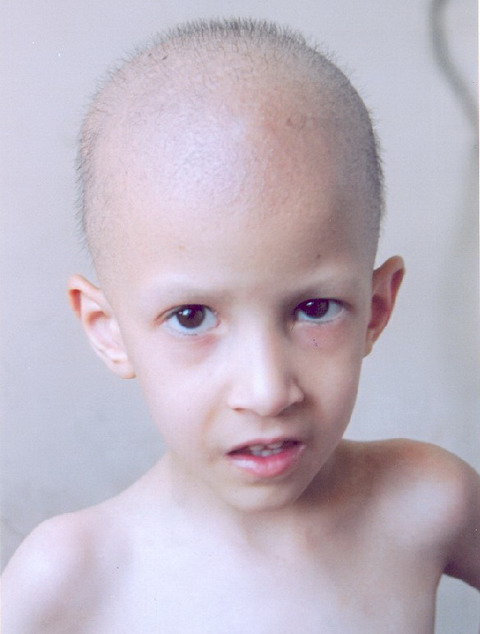Abstract
Monilethrix is a genetic disorder of hair shaft structure characterized
by increased fragility. We report a 6 year old boy with monilethrix in view
of rarity of this disorder.
Introduction
Monilethrix is a rare autosomal dominant disorder of hair. There is an
alternating widening and narrowing of the hair shaft. The narrow portions
of the hair shaft are prone to fracture easily resulting in varying degrees
of alopecia.
Case report
A 6 years old boy born of non-consanguineous marriage presented to the
outpatient department with poor growth of hair starting after a few months
of normal hair growth in infancy. His parents noticed that the hair did
not grow beyond a certain length. There was no history of this disorder
in any of the family members.
His mental and physical growth was normal. The scalp showed diffuse hair
loss with scattered short stubby hair of few centimeters in length. There
were prominent horny follicular papules over the vertex and nape of the
neck with hair emerging from the summit giving the scalp a rough feel (Fig.1).
His eyebrows and eyelashes were sparse and short (Fig.2). Hair was absent
on the rest of the body and multiple skin colored horny papules were seen
on the upper back. The light microscopic examination of the hair shaft revealed
the pathogonomic finding of alternating node (widening) and internode (narrowing)
confirming the diagnosis of monilethrix.
 | Fig 1:
Diffuse alopecia with scattered short stubby hair and prominent
horny follicular papules over the vertex of the scalp. |
|
 | Fig
2: Short and sparse eyebrows and eyelashes. |
|
Discussion
This genetic disorder of hair shaft structure with increased fragility
was first described by Walter Smith in 1879 as "a rare nodose condition
of the hair" [1]. Radcliffe Crocker suggested
the term monilethrix which is derived from the Greek meaning necklace hair.
This developmental abnormality of the hair shaft is inherited in an autosomal
dominant manner with high penetrance and variable expressivity. The hair
growth is normal at birth and is replaced by short brittle hair during the
first few months of life. The short stubble brittle hairs are more prominent
on the occiput and the nape of the neck and are seen emerging from the top
of the horny follicular papules. The eyebrows, eyelashes, axillary and pubic
hair and the hair on the rest of the body may also be affected. The susceptibility
to premature weathering results in its inability to attain normal length.
The condition has been known to persist throughout life but in some cases
it may resolve spontaneously [2,3].
The light microscopic examination reveals alternating wider elliptical
nodes and narrower internodes. The premature weathering and breakage is
seen at the fragile internodes. Transmission microscopy of the internode
showed deviation in the axis of the macrofibrils within the cortical cells
and disorganized globular inter-macrofibrillar cystine rich material [4].
The uneven transverse distribution of this matrix protein is thought to
contribute for the asymmetrical tension and subsequent fragility. The internodes
occur at the site of a greater cortical defect due to the effect of compression
by the inner root sheath during keratinization process and is seen as invagination
of the cuticle into the weakened cortex [1].
The regular elliptical beading of the hair shaft occurs as a secondary feature
due to the abnormal intermittent activity of the basal cells producing the
cortical protein.
Other associated abnormalities seen with monilethrix include trichorrhexis
nodosa, juvenile cataracts, syndactyl, nail and teeth abnormalities.
There is no specific treatment for this condition, although some improvement
has been seen with oral retinoids, griseofulvin, iron supplementation and
topical minoxidil [5,6,7,8].
References
1. De-Berker DAR, Ferguson DJ, Dawber RPR. Monilethrix:
a clinicopathological illustrating of cortical defect. Br J Dermatol 1993:
128: 327- 331.
2. Solomon IL, Green OC. Monilethrix. N Engl J Med 1963;
269: 1279- 1285.
3. SmithWG. A rare nodose condition of the hair. BMJ 1879;
11: 291- 296.
4. Gummer CL, Dawber RPR, Swift JA. Monilethrix: an electron
microscopic and electron histochemical study.Br J Dermatol 1981; 105:529-
541.
5. De-Berker DAR, Dawber RPR. Monilethrix treated with oral
retinoids. Clin Exp Dermatol 1990; 16: 226- 228.
6. Keipert JA.The effect of griseofulvin on yhe hair growth
in monilethrix. Med J Aust 1973; 1: 1236- 1238.
7. Karaman GC, Sendur N, Basar H, Bozkurt SE. Localized
monilethrix with improvement after treatment of iron deficiency anemia.
J Eur Acad Dermatol Venerol 2001; 15: 362- 364.
8. Saxena U, Rmaeshv, Misra RS. Topical minoxidal in monilethrix.
Dermatologica 1991; 182: 252- 253.© 2010 Egyptian Dermatology Online Journal
|


